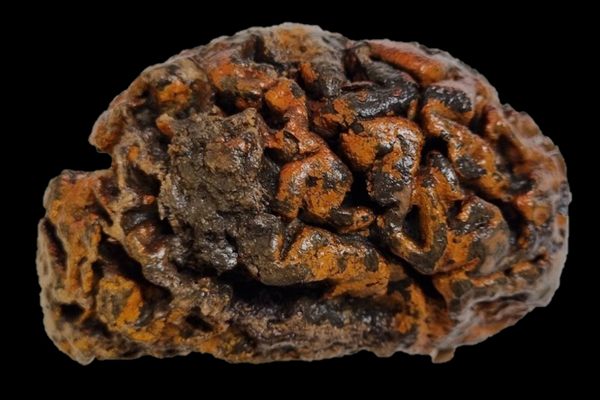Found: 14,400-Year-Old Flatbread Remains That Predate Agriculture
The burned crumbs shed light on prehistoric hunter-gatherers’ diets.

Bread-making around the world has evolved from a similar, ancient approach of combining flour, water, and sometimes yeast. But for prehistoric societies with limited tools, making bread wasn’t so simple. Given how laborious it was to make bread thousands of years ago, it’s long been associated with settled Neolithic societies—and only after the advent of agriculture.
That’s no longer the case. Today, a team of researchers from the University of Copenhagen, the University College London, and the University of Cambridge released a paper in the Proceedings of the National Academy of Sciences detailing their discovery of 14,400-year-old crumbs from a flatbread. The archaeological site, known as Shubayqa 1, is located in the Black Desert of northeastern Jordan and was home to Natufian hunter-gatherers. The flatbread remains are not only the oldest instance of bread found to date, but also preeminent examples of how bread-making existed even before agriculture developed some 4,000 years later.
“Nobody had found any direct evidence for production of bread, so the fact that bread predates agriculture is kind of stunning,” says Tobias Richter, a University of Copenhagen archaeologist who co-authored the paper. “Because making bread is quite labor-intensive, and you don’t necessarily get a huge return for it. So it doesn’t seem like an economical thing to do.” That’s because breadmaking doesn’t just involve baking: Back then, it would have also involved kneading, grinding cereals into fine grains, and dehusking plants.
Before the find at Shubayqa 1, the closest evidence of bread-like cereal meals had been identified at the Neolithic site Çatalhöyük, in Turkey. “We really didn’t think up until now that in the Natufian [period], people were making bread,” he adds. “We’ve just pushed that 5,000 years earlier.”
For years, researchers have been excavating Shubayqa 1 to learn more about the Natufians’ diet and lifestyle. “Natufian is a very interesting period in Near Eastern prehistory, because it does mark a real point of departure with some of the preceding periods,” Richter says. “They built some of the world’s earliest stone dwellings, and appear to have been more sedentary than periods before then.”

Richter says that compared to other Natufian sites, Shubayqa 1 is unusual in how well-preserved its plants are, and it reveals intriguing possibilities about the relationship between social change, economic shifts, and climate change. Previous findings suggest, for instance, that the Natufians had high-carbohydrate diets, hunted animals such as gazelles, and, as evidenced by their elaborate burials, had well-established cultural rituals.
The bread discovery happened by chance, when Amaia Arranz Otaegui, an archaeobotanist at the University of Copenhagen, found unidentifiable charred remains in fireplaces at Shubayqa 1. She took her findings to University College London’s Institute of Archaeology, which has a trove of modern plants that archaeologists can compare their findings to. There, she enlisted the help of Lara González Carretero, an authority on prehistoric bread. Using electronic microscopy, she determined that the charred remains—which Richter describes as “the kind of stuff you might find at the bottom of your toaster”—was likely evidence of unleavened bread.
Until recently, food remains weren’t given much attention within archaeological digs. “Mostly up until now archaeobotanists have been interested in seeds, wood fragments, and nuts and so forth,” Richter says. “It’s fairly new that people have started to look at food remains in these sediment samples that we’re excavating from various sites.” Several years ago, a team of researchers excavating the Natufian site Huzuq Musa (in Israel’s Jordan Valley) processed wild barley and loaves of unleavened bread using 12,500-year-old conical mortars. Some experts have speculated that bread-baking stretches back even further than 14,400 years ago.

Over the years, fossilized loaves and bread-making grains alike have been unearthed at archaeological sites, such as Italy’s Pompeii and Ohalo II, in what’s now considered Israel, respectively. But the recently discovered flatbread remains at Shubayqa 1 bear similarities to those found at various other sites around Turkey and Europe, too. “So we now know that bread-like products were produced long before the development of farming,” said Arranz Otaegui. “The next step is to evaluate if the production and consumption of bread influenced the emergence of plant cultivation and domestication at all.”
How Natufians made this bread, exactly, remains up for debate. “What’s quite surprising from the work we’ve done so far is that the flour they used is really fine, and you wonder, ‘How the hell did they do that?’” Richter says. “[It’s] really high-quality, so they must have spent a lot of time getting it into a really fine state.” He says the team has been awarded another grant to study food production, so making a very old flatbread is on the table. “One of the things we want to do next is to try and reproduce this bread experimentally,” Richter says. “And see what it tasted like.”
Gastro Obscura covers the world’s most wondrous food and drink.
Sign up for our regular newsletter.


































Follow us on Twitter to get the latest on the world's hidden wonders.
Like us on Facebook to get the latest on the world's hidden wonders.
Follow us on Twitter Like us on Facebook